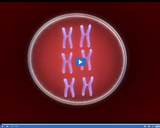
Chromosomes are located in the nucleus of every cell in a living thing.
- Subject:
- Science
- Provider:
- Utah Education Network
- Author:
- Visual Learning Company
- Date Added:
- 02/28/2010

Chromosomes are located in the nucleus of every cell in a living thing.
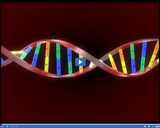
Scientists refer to the shape of a DNA molecule as a double helix. Rungs on the double helix are formed by substances called nitrogen bases.
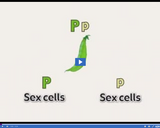
A male sex cell unites with a female sex cell to form a fertilized egg.
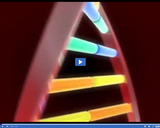
There are four different types of nitrogen bases in DNA, which combine in specific ways. The sequence of nitrogen bases determines the particular genes on a chromosome and the genetic code.
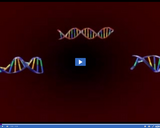
Recombinant DNA is created by inserting a DNA segment or gene from one organism into another. DNA is usually transferred from a complex organism to a simple organism, such as bacterium.

In this lesson, students retell original stories that may include text, drawings, photos or animation and must have audio and video. They will use technology tools, such as Chromebooks to bring the chosen biography to life. Story ideas can come from people who are historical figures or someone a student considers is important to our community.

This lesson has been created to use with a 6th grade class. The format is a genius hour format. Students will be choosing a topic on a current event and researching that current event. They will create an infographic using Adobe Spark that shows the inforamation they found.The graphic for the cover page was created by Jean Robinson using Canva.
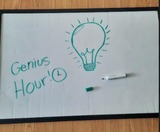
This lesson plan is about how to use Genius Hour teaching to individualize and deepen students' learning in a general topic. Image create by: Magdalene Allred, Image taken by: Heidi AllredAligns with Utah Core Objectives UETS 6aObjecives: to deepen learning by researching and creating a project about current curriculum
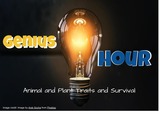
This is the first lesson in a set of lessons to teach about animal and plant adaptations and their relation to survival in a Genius Hour Format. Genius Hour is just a process where students choose an interesting topic, generate a deep question and research to find the answer to that question. The students then create a product that showcases that learning. Background knowledge for this lesson uses resources from the State Board of Education and Generation Genius but they are not essential to the lesson. image from pixabay, no attribution required

This lesson plan is the beginning of Genius Hour in the classroom. It is a whole-class Genius Hour project that is designed to help students get an idea of how Genius Hour works. "Mickey Mouse" by ross_hawkes is licensed under CC BY 2.0.

Video created through Adobe Spark introducing third graders to Genius Hour.
Genius Hour Elevator Pitch © 2019 by A. Nielson is licensed under CC BY-NC-SA 4.0
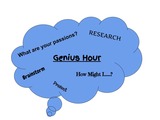
This genius hour unit is a simple guiding outline to support students in completing an extension passion project during genius hour. It will guide them through brainstorming, researching and presenting. Original Image Created By Angela Harker

Overview:Students will be creating a video regarding a topic of their choice. In terms of content, it is very flexible. It can be a short documentary, a how-to video, a presentation, a video showing off a hobby, ect. They will be spending most of their time researching and practicing for their video, with time taken aside to collect feedback from their peers in terms of stand-up meetings and exit tickets. After a couple drafts, a final video project will be presented.Thumbnail created by me: Erik Mineer
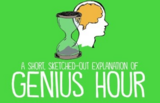
This resource is for teachers to aid students through the expeditionary and inquiry-based learning process of Genius Hour. Genius Hour is a passion project students can participate in using 20% of class time every week (about 1 hour). They will learn how to ask good questions around a topic they're interested in, conduct research, and ultimately produce and present evidence from their findings.Time frame: 1 hour per week every term (About 10 hours)Format: asynchronous, virtual, or in class with groups

Students should have autonomy in their learning and be given the opportunity to light their interest in learning about something that intrigues them. At times they don't know how to start this process or to do it effectively to find their answers. In this Genius Hour Introduction and Plan students will learn how to research, find answers and create a project that they can share with others to share what they learned while taking autonomy in their learning. Thumbnail image link website.

This is a genius hour leson I plan on using with my students. Genius Hour is an approach to learning where students are guided by their own interests, background knowledge, and curiosity to learn. Picture taken by Sarah DeHart
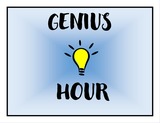
These lessons are intended as an introduction to Genius Hour for younger students in the elementary grades. It focuses on students' interests and/or hobbies they wish to explore, developing research questions appropriate for their topic, and an introduction to teaching research using digital databases and other resources.

This is a lesson plan on how to introduce a Genius Hour project on Ancient Civilization architecture. Students will study what made these famous structures last.Preview image by PIXNIO
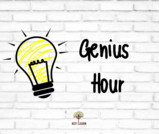
This is a mini lesson on how to attempt a genius hour project and present it
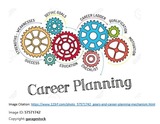
This Genius Hour project will focus on student’s in special education and their IEP transition goals related to their career interests. Students will select one career of interest to them and conduct research, interview people in the field, job shadow, etc. to develop a presentation on their findings.